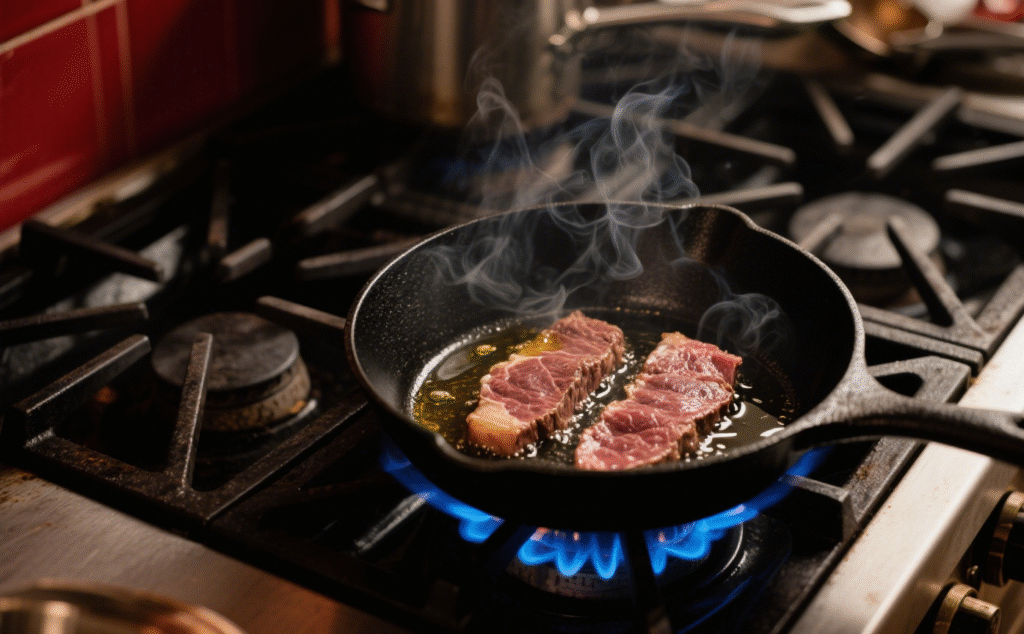This post may contain affiliate links which means we may receive a commission at no cost to you, if you make a purchase through a link. Please see our full disclosure for further information.
It’s easy to cook a perfect steak. You don’t need a fancy kitchen. You just need the right way to cook it. This post will show you two ways to cook any steak. We’ll cover the butter basting and reverse sear methods.
Steaks come in many sizes. So, you need different ways to cook them. The first way is for smaller steaks. The second is for bigger steaks.
Butter Basting: Best for Smaller Steaks
For smaller steaks, like filet mignon, use the butter basting method. This method cooks the steak quickly.
Season the Steak
First, season your filet with salt and pepper. Use a lot of salt and pepper. Some people let the steak sit in the fridge overnight after seasoning. But for smaller steaks, this can dry them out.
Sear the Steak
Next, you need a heavy pan. Cast iron or stainless steel pans work best. Cover the bottom of the pan with oil. Use more oil than you think you need. This helps the steak brown evenly. Use an oil that can handle high heat.
Turn up the heat. Heat is very important for a perfect steak. Don’t be afraid of high heat. Add a little more oil to the top of the steak just before searing.
When the pan is very hot and the oil is barely smoking, put the steak in. Press down on the steak right away. Hold it down for a few seconds. Then, turn the heat down to medium-low.
Let the steak cook. Watch the edges for browning. Control the heat to avoid burning. Don’t touch the steak yet.
Flip and Sear Again
When the edges are golden brown, it’s time to flip. Turn the heat back up for a few seconds. Make sure the steak isn’t stuck to the pan. It should come loose easily.
Flip the steak. You should see a crust on the first side. Now, get a crust on the other side. Keep the heat high for a few more seconds. Then, turn it down again.
Lift the steak and move it to a new spot with hot oil. This helps get the crust you want.
Butter Baste
Once both sides have a golden-brown crust, pour off the oil. Wipe the pan to remove any bits that might burn. Put the steak back in the pan. Turn the heat to low.
Add half a stick of butter. You can use more if you love butter. Add half a head of garlic and a few sprigs of rosemary to the butter. Let the butter heat up with these flavors.
Tilt the pan so the butter pools. Spoon the hot butter over the steak. This is called butter basting. The hot, flavorful butter cooks the steak. The smell is amazing.
Keep the heat low to avoid burning the butter. Cook the steak with the brown butter. Flip the steak halfway through. This cooks both sides evenly.
Check the Temperature
Check the steak’s temperature. For medium, aim for 140 to 145°F. If you cook steaks often, you can pinch it to know when it’s done.
Place the herbs and garlic on top of the steak. Pour the brown butter over it. This adds more flavor as it rests.
Rest and Serve
Let the steak rest for ten minutes. This locks in the juices.
Cut into the steak. It should be medium in the middle with a crispy crust. Spoon over some of the extra brown butter. Add some crispy rosemary.
Ready to try it yourself? With these easy steps, you can cook a perfect steak at home.
Reverse Sear: Best for Thicker Steaks
The second way to cook a steak is the reverse sear method. This works best for thicker steaks, like ribeye. You cook the steak in the oven first. This cooks it evenly. Then, you sear it in a pan to get a golden-brown crust.
Season and Rest
Season the steak with a lot of salt on all sides and edges. Now, you have two choices. You can cook it right away. Or, you can put it in the fridge overnight. Letting it sit overnight will dry out the edges. This gives you a better crust.
If you let it sit overnight, you’ll notice that the salt dissolves into the steak. A hard crust will form.
Bake in the Oven
Put the steak in the oven at 300°F. Use a thermometer to check the temperature. For medium, cook it to 140 to 145°F.
Pull the steak out when it’s about 7 to 10 degrees away from the final temperature. The outside won’t look very good yet. But the inside is cooked.
Sear for the Crust
Turn the burner to high. You only need to sear the steak to get a crust. Use a cast iron skillet. Add enough oil to cover the bottom of the pan.
When the oil ripples and lightly smokes, put the steak in. Keep the heat high. Sear it quickly on each side. This gives you a fast, golden-brown crust. The inside is already cooked, so you don’t need to cook it long.
Rest and Serve
Let the steak rest for at least ten minutes. This locks in the juices.
Trim the outer ribeye cap and eat it separately. These are very special, fatty bites. Cut the steak into thick pieces. Lay them on a plate. Add a flavored butter and chives for color. Finish with fresh cracked pepper.
Now that you’ve mastered the two core methods, let’s dive into extra tips to elevate your steak game—from nailing the perfect doneness to choosing the right cuts, and even troubleshooting common mishaps.
Perfect Doneness: A Temperature Cheat Sheet
You know medium is 140–145°F, but what about other levels? Here’s how to hit your ideal bite:
- Rare: 125–130°F. Cool, red center with a seared crust—juicy and tender, best for high-quality, well-marbled steaks like ribeye.
- Medium-Rare: 130–135°F. Warm, pink center (about ½ inch of red in the middle). The sweet spot for most steak lovers, balancing juiciness and flavor.
- Medium-Well: 150–155°F. Mostly brown with a hint of pink. Less juicy but still tender if cooked carefully—good for leaner cuts like sirloin.
- Well-Done: 160°F+. Fully brown throughout. Riskier for drying out, so stick to thicker cuts (1.5+ inches) and avoid overcooking.
Pro tip: Always pull the steak 5–10°F below your target temp—carryover cooking (the steak keeps heating after removing from heat) will push it to perfect doneness during resting.
Choosing the Right Steak Cut
Not all steaks are created equal. Here’s how to match the cut to your cooking method:
- Filet Mignon: Tender, lean, and small (3–4 ounces). Perfect for butter basting—its mild flavor soaks up the garlic and rosemary butter beautifully.
- Ribeye: Rich, marbled, and thick (1–2 inches). A star for reverse searing—the fat melts as it bakes, keeping the meat juicy, while the reverse sear locks in that crispy crust.
- Sirloin: Leaner with a bold, beefy flavor. Works for both methods, but opt for butter basting if it’s thin (under 1 inch) or reverse sear if thicker—its leanness means overcooking risks dryness, so watch that temp!
- New York Strip: A happy medium—tender with moderate marbling. Great for butter basting (smaller cuts) or reverse searing (thicker ones), with a slightly firmer texture than ribeye.
Troubleshooting: Fixing Common Mistakes
Even pros slip up—here’s how to course-correct:
- Steak sticks to the pan? You didn’t let the pan get hot enough. Wait until oil shimmers and just starts to smoke before adding the steak; the crust will form quickly, preventing sticking.
- Butter burns during basting? Keep the heat low. Brown butter is good (nutty, rich), but black butter is bitter. If it starts to smoke, remove the pan from heat for 10 seconds, then resume basting.
- Steak is dry? Overcooking is usually the culprit, but under-resting matters too. Skipping the 10-minute rest lets juices run out when you cut into it—patience pays off! For lean cuts (like sirloin), err on the side of undercooking slightly.
Elevating Flavor: Beyond Salt and Pepper
While a good steak needs little more than salt and pepper, these add-ons can take it up a notch—without overpowering the meat:
- Herbs: Swap rosemary for thyme, sage, or even a sprig of oregano for a fresh twist. Garlic lovers can crush a few cloves instead of leaving them whole for more pungent flavor.
- Spices: A pinch of smoked paprika or a sprinkle of chili flakes adds subtle warmth (great with ribeye). For something earthy, try a dusting of dried porcini powder.
- Compound Butter: Mix softened butter with chopped chives, parsley, or even a dash of Worcestershire sauce. Slap a pat on top of the resting steak—its melt will seep into every crevice.
Leftovers? Make Them Shine
Leftover steak doesn’t have to be sad. Slice it thin for:
- Steak salad: Toss with arugula, cherry tomatoes, and a lemon-garlic vinaigrette.
- Steak and eggs: Fry up a egg and serve over sliced steak with a side of hash browns.
- Steak sandwich: Pile on a crusty roll with caramelized onions and horseradish mayo—sear the sandwich in a pan for a crispy finish.
Cooking steak is as much about feel as it is about steps. With practice, you’ll learn to read the crust, judge the weight of a “done” steak in your hand, and tweak the methods to match your taste. Whether you’re craving a buttery filet or a bold, crusty ribeye, these tips will turn your home kitchen into a steakhouse—no fancy tools required.
Final Thoughts
Making the perfect steak is about using the right way to cook it. You don’t need fancy tools or a pro kitchen. You just need a good steak and the right way to cook it. Now fire up that pan (or oven) and let the searing begin. Your perfect steak is just a few steps away.
Steak 101: How to buy the right steak
Tips & Tricks for Preparing the Perfect Steak
A Complete Guide to Steak
A Steak Lover’s Guide: How to Choose the Perfect Cut
Uncover further inspiration in our blog.






























